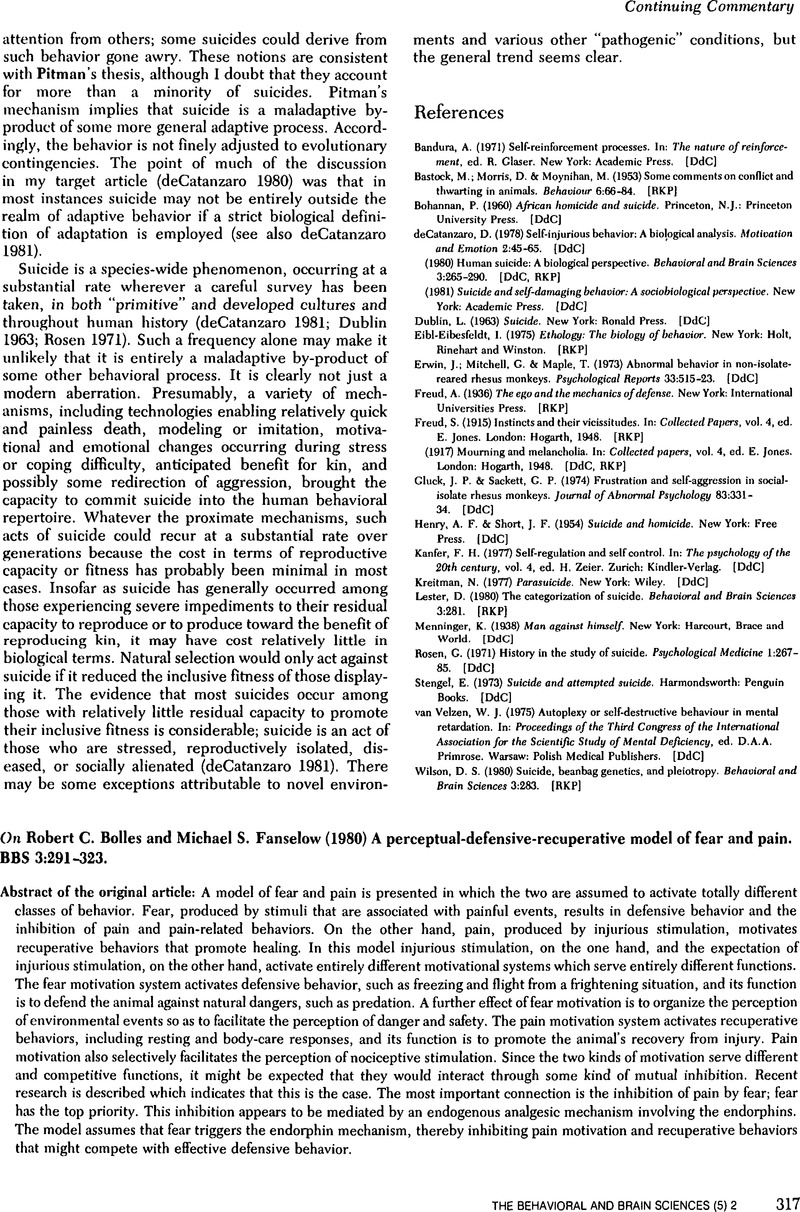No CrossRef data available.
Article contents
Pain is pain and fear is fear
Published online by Cambridge University Press: 04 February 2010
Abstract
An abstract is not available for this content so a preview has been provided. Please use the Get access link above for information on how to access this content.

- Type
- Continuing Commentary
- Information
- Behavioral and Brain Sciences , Volume 5 , Issue 2: Special Symposium Issue , June 1982 , pp. 318 - 320
- Copyright
- Copyright © Cambridge University Press 1982
References
Beluzzi, J. D.; Grant, N.; Garsky, V.; Sarantalds, D.; Wise, C. D. & Stein, L. (1976) Analgesia induced in vivo by central administration of enkephalin in rat. Nature 260:625–26. [HU]CrossRefGoogle Scholar
Bindra, D. (1978) How adaptive behavior is produced: A perceptual-motivational alternative to response-reinforcement. Behavioral and Brain Sciences 1:41–91. [MSF]Google Scholar
Bolles, R. C. (1972) Reinforcement, expectancy, and learning. Psychological Review 79:394–409. [MSF]CrossRefGoogle Scholar
Bolles, R. C. & Fanselow, M. S. (1980) A perceptual-defensive-recuperative model of fear and pain. Behavioral and Brain Sciences 3:291–323. [MSF, NJM, HU]CrossRefGoogle Scholar
Bolles, R. C. & Fanselow, M. S. (1982) Endorphins and behavior. Annual Review of Psychology 33: in press. [MSF]CrossRefGoogle ScholarPubMed
Bykov, K. M. (1957) The cerebral cortex and the internal organs. New York: Chemical Publishing Co. [NJM]Google Scholar
Chance, W. T. (1980) Autoanalgesia: Opiate and non-opiate mechanisms. Neuroscience and Biobehavioral Reviews 4:55–67. [MSF]Google Scholar
Coover, G. D., Ursin, H. & Levine, S. (1973) Plasma-corticosterone levels during active avoidance learning in rats, Journal of Comparative and Physiological Psychology 82:170–74. [HU]CrossRefGoogle ScholarPubMed
Doty, R. W. & Giurgea, C. (1961) Conditioned reflexes established by coupling electrical excitation of two cortical areas. In: Brain mechanisms and learning, ed. Delafresnaye, J. F., Fessard, A., Gerard, R. W. & Konorski, J.. Oxford: Blackwell Scientific Press. [HU]Google Scholar
Eysenck, H. J. (1979) The conditioning model of neurosis. Behavioral and Brain Sciences 2:155–99. [HU]CrossRefGoogle Scholar
Eysenck, H. J. (1980) Fear, pain, and arousal. Behavioral and Brain Sciences 3:307–8. [HU]CrossRefGoogle Scholar
Fanselow, M. S. (1980a) Conditional and unconditional components of postshock freezing. Pavlovian Journal of Biological Science 15:177–82. [MSF]Google Scholar
Fanselow, M. S. (1980b) Signaled shock-free periods and preference for signaled shock. Journal of Experimental Psychology: Animal Behavior Processes 6:65–80.Google Scholar
Fanselow, M. S. (1981) A role for endogenous opiates in defensive behavior. Paper presented at the 52nd meeting of the Eastern Psychological Association, New York. [MSF]Google Scholar
Fanselow, M. S. & Bolles, R. C. (1979) Naloxone and shock-elicited freezing in the rat. Journal of Comparative and Physiological Psychology 93:736–44. [MSF]CrossRefGoogle ScholarPubMed
Flaherty, C. F.; Uzwiak, A. J.; Levine, J.; Smith, M.; Hall, P. & Schuler, R. (1980) Apparent hyperglycemic and hypoglycemic conditioned responses with exogenous insulin as the unconditioned stimulus. Animal Learning and Behavior 8:382–86. [MSF]CrossRefGoogle Scholar
Gibson, J. J. (1977) The theory of affordances. In: Perceiving, acting and knowing: Toward an ecological psychology, ed. Shaw, R. & Bransford, J.. Hillsdale, N.J.: Erlbaum. [MSF]Google Scholar
Glazer, H. I. & Weiss, J. M. (1976) Long-term and transitory interference effects. Journal of Experimental Psychology: Animal Behavior Processes 2:191–201. [NJM]Google Scholar
Gray, J. (1975) Elements of a two-process theory of learning. London: Academic Press. [HU]Google Scholar
Greenberg, G. (1980) Premature theorizing is not always parsimonious. Behavioral and Brain Sciences 3:310–11. [HU]Google Scholar
Holland, P. C. (1977) Conditioned stimulus as a determinant of the form of the Pavlovian conditioned response. Journal of Experimental Psychology: Animal Behavior Processes 3:77–104. [MSF]Google ScholarPubMed
Jordan, B. (1978) Birth in four cultures: A crosscultural investigation of childbirth in Yucatan, Holland, Sweden and the United States. St. Albans, Vt: Eden Press Women's Publications. [MSF]Google Scholar
Levine, S., Weinberg, J. & Ursin, H. (1978) Definition of the coping process and statement of the problem. In: Psychobiology of stress: A study of copingmen, ed. Ursin, H., Baade, E. & Levine, S.. New York: Academic Press. [HU]Google Scholar
MacLennan, A. J., Jackson, R. L. & Maier, S. F. (1980) Conditioned analgesia in the rat. Bulletin of the Psychonomic Society 15:387–90. [MSF]CrossRefGoogle Scholar
Øhman, A. & Ursin, H. (1979) On the sufficiency of a Pavlovian conditioning model for coping with the complexities of neurosis. Behavioral and Brain Sciences 2:179–80. [HU]CrossRefGoogle Scholar
Rescorla, R. A. (1974) Effect of inflation of the unconditioned stimulus value following conditioning. Journal of Comparative and Physiological Psychology 86:101–6. [MSF]CrossRefGoogle Scholar
Schull, J. (1979) A conditioned opponent theory of Pavlovian conditioning and habituation. In: The psychology of learning and motivation, ed. Bower, C., vol. 13. New York: Academic Press. [MSF, NJM]Google Scholar
Siegel, S. (1977) Morphine tolerance acquisition as an associative process. Journal of Experimental Psychology: Animal Behavior Processes 3:1–13. [MSF, NJM]Google ScholarPubMed
Siegel, S., Hinson, R. E. & Krank, M. D. (1978) The role of pre-drug signals in morphine analgesic tolerance: Support for a Pavlovian conditioning model of tolerance. Journal of Experimental Psychology: Animal Behavior Processes 4:188–96. [MSF]Google Scholar
Solomon, R. L. & Corbit, J. D. (1974) An opponent-process theory of motivation: I. Temporal dynamics of affect. Psychological Review 81:119–45. [MSF, NJM]CrossRefGoogle ScholarPubMed
Ursin, H. (1980) Affective and instrumental aspects of fear and aggression. In: Functional states of the brain: Their determinants, ed. Koukkou, M., Lehmann, D., & Angst, J.. Amsterdam: Elsevier. [HU]Google Scholar
Ursin, H., Wester, K. & Ursin, R. (1967) Habituation to electrical stimulation of the brain in unanesthetized cats. Electroencephalography and Clinical Neurophysiology 23:41–49. [HU]CrossRefGoogle ScholarPubMed
Zener, K. (1937) The significance of behavior accompanying conditioned salivary secretion for theories of the conditioned response. American Journal of Psychology 50:384–403. [MSF]CrossRefGoogle Scholar


